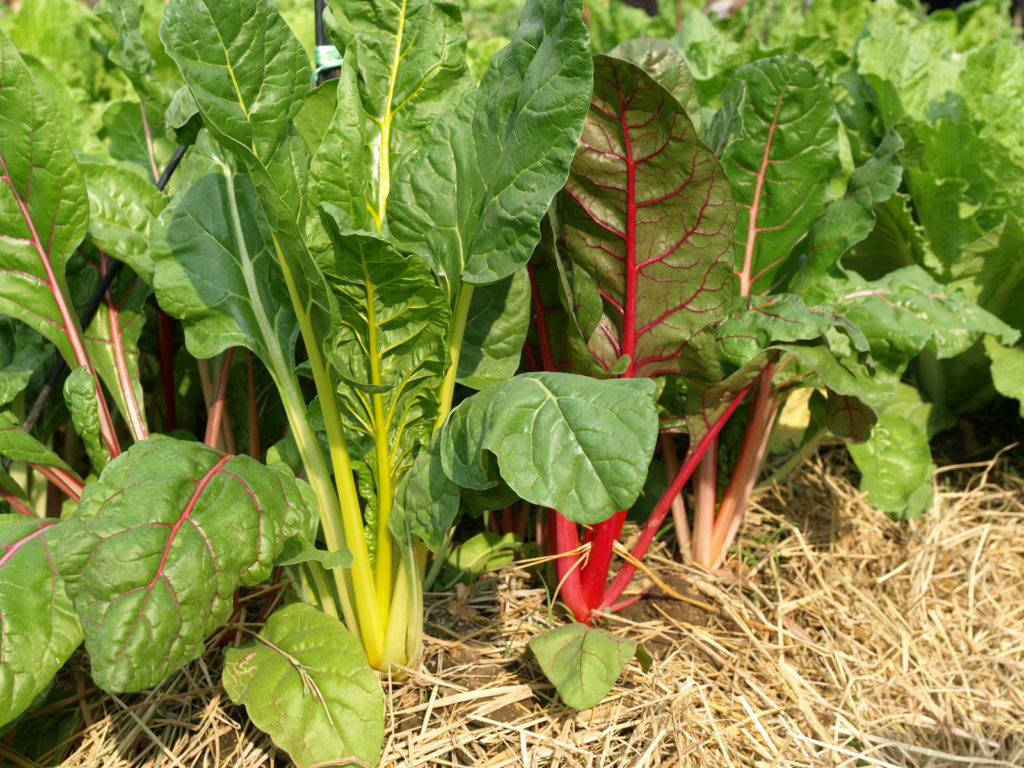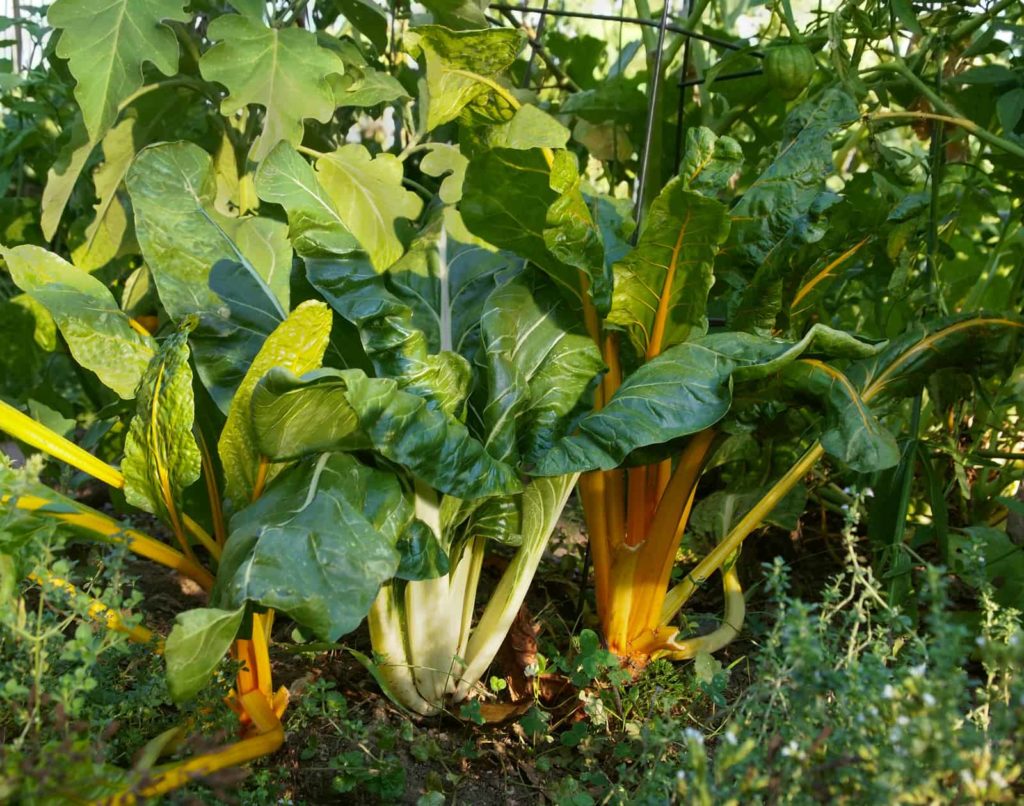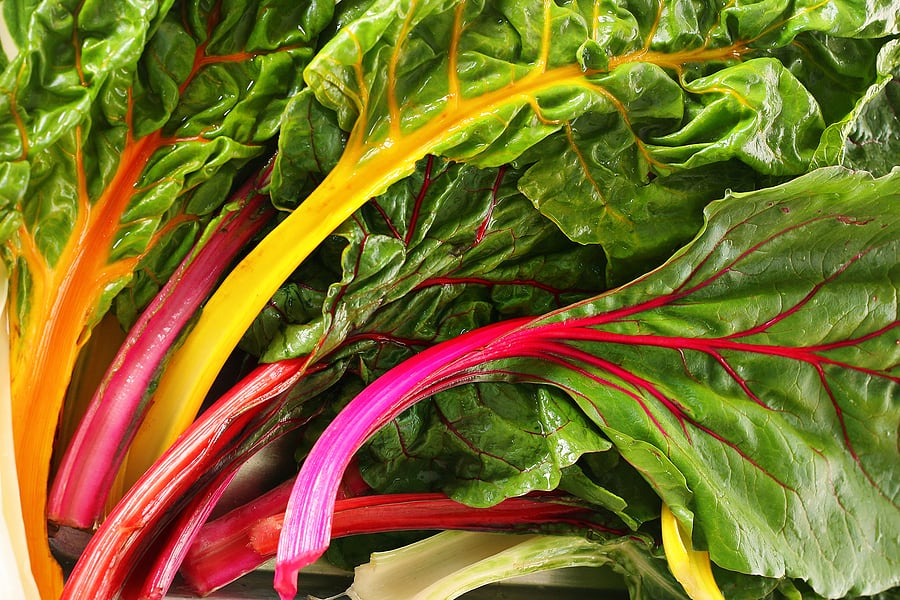Swiss chard is a member of the beet family grown for its rosette of large, crinkly green leaves on thick red, white, or rainbow stalks. Plants can grow to 16 inches tall and leaves and stalks can be harvested several times over the course of a season on a cut-and-come-again schedule.
Swiss chard can be served raw or cooked.
Related articles:
- Five Ways to Cook and Serve Swiss Chard
- Swiss Chard Seed Starting Tips
- Chard Soup Made Simply
- Growing Swiss Chard in Containers
- Swiss Chard Seed Starting Tips
- How to Plant and Grow Swiss Chard
- How to Harvest and Store Swiss Chard
- Swiss Chard Growing Problems Troubleshooting

Swiss chard quick growing tips
- Swiss chard grows best in the cooler time of the year. Sow chard in the garden 2 to 4 weeks after all frost has passed in spring. Grow Swiss chard again in autumn,
- To get an early start, sow Swiss chard indoors as early as 3 to 4 weeks before the average last frost date in spring for transplanting out when plants are 3 to 4 inches (7-10cm) tall.
- Once established Swiss chard will tolerate heat and frost. Plant chard also in summer for a fall harvest.
- Swiss chard yield: plant 2 to 3 chard plants per household member.
Good Products for Growing Swiss Chard at Amazon:
- Garden Safe Snail and Slug Bait
- Bonide Sulfur Fungicide
- Monterey BT Caterpillar Killer
- Neem Bliss 100-% Cold Pressed Neem Oil
Where to grow Swiss Chard
- Grow Swiss chard in full sun; chard will tolerate partial shade.
- Swiss chard grows best in well-worked, well-drained soil rich in organic matter, although chard does not favor soil that is too acidic.
- Swiss chard grows best in a soil pH of 6.0 to 6.8.

When to plant Swiss Chard
- Swiss chard grows best in cool temperatures; high temperatures will slow down leaf production.
- Sow chard in the garden 2 to 4 weeks after all frost has passed in spring.
- To get an early start, sow chard indoors as early as 3 to 4 weeks before the average last frost date in spring for transplanting out when plants are 3 to 4 inches (7-10cm) tall.
- Plant Swiss chard also in summer for a fall harvest.
- Once established Swiss chard will tolerate heat and frost.
- In mild-winter climates, Swiss chard can be grown through the winter.
Planting and spacing Swiss Card
- Sow Swiss chard seed ½ inch deep from 1 to 2 inches (2.5-5cm) apart.
- Thin successful seedlings from 8 to 12 inches (20-30cm) apart.
- Space rows 18 to 24 inches (45-61cm) apart. Chard grows from a seed cluster (several seeds to a cluster, similar to beets).
- Seed clusters are likely to produce several seedlings so thin to the strongest seedling once plants are 3 inches (7cm) tall. Cut the weaker seedlings off at the soil level with small scissors.
- Swiss chard can grow crowded, but leaves will be smaller.
- Crowded plants may tend to bolt and go to seed more quickly.
Container growing Swiss Chard
- Swiss chard will grow in an 8-inch (20cm) pot. Plant 2 or 3 plants in a container.
- In larger containers, set chard in wide rows on 8-inch (20cm) centers.
- Pick older, outside leaves first and allow young, tender leaves to grow on.

Watering and feeding Swiss Chard
- Keep Swiss chard planting bed evenly moist for quick, tender growth.
- Prepare planting beds with well-aged compost in advance of sowing.
- Side dress chard with aged compost at midseason.
Swiss Chard companion plants
- Good companion plants for Swiss chard include chicory, garlic, leeks, mustard, and onions.
- Avoid growing Swiss chard with legumes, potatoes, or tomatoes.
Swiss Chard pests and diseases
- Aphids and leaf miners will attack chard. Control aphids by pinching out the affected leaves or spraying them away with a blast of water.
- Leaf miners feed on the inside of leaf surfaces. Remove leaves with significant leaf miner damage and look underneath leaves for a row of pearl-white eggs; destroy them.
- Swiss chard has no serious disease problems.

Harvesting Swiss Chard
- Swiss chard will be ready for harvest in 55 to 60 days from sowing.
- Pick outside leaves as early as three inches long but before leaves grow to 10 inches long. Older leaves will have an earthy flavor.
- Harvest Swiss chard on a cut-and-come-again schedule; remove a few outside leaves at a time.
- If you harvest the whole plant, cut it back to about 3 inches (7cm) above the soil and it will grow back.
- Chard that overwinters can be harvested again in the second year.
Storing Swiss Chard
- Chard will keep in the refrigerator for 2 weeks.
- Chard will keep in the freezer for up to 6 months if you remove the stem.
Swiss Chard varieties to grow
- Dark green, crumpled leaves: Argentata (55 days); Fordhook Giant (60 days); White King (55 days).
- Red chard: Rainbow (60 days); Ruby Red (55 days); Vulcan (60 days).
- Dark green smooth leaves: French Swiss Chard (60 days); Green (60 days); Perpetual (50 days).
- Light green chard: Giant Lucullus (50 days); Lucullus (50 days).
About Swiss Chard
- Common name. Chard, Swiss chard, sea kale, Swiss beet, sea kale beet.
- Botanical name. Beta vulgaris cicla
- Origin. Europe, Mediterranean
Swiss chard articles at Harvest to Table:
How to Plant and Grow Swiss Chard
Swiss Chard Seed Starting Tips
Growing Swiss Chard in Containers
How to Harvest and Store Swiss Chard
Five Ways to Cook and Serve Swiss Chard
Beets and Swiss Chard Growing Problems Troubleshooting
More how to grow articles:
Learn how to plant, grow, and harvest your favorite vegetables. Click below for all you need to know.
- Artichoke
- Arugula
- Asparagus
- Beans, Snap
- Beets
- Broad Beans
- Broccoli
- Brussels Sprouts
- Cabbage
- Cantaloupe — Melons
- Cardoon
- Carrots
- Cauliflower
- Celeriac
- Celery
- Chard
- Chayote Squash
- Chickpeas
- Chicory
- Chinese Cabbage
- Collards
- Corn Salad
- Corn, Sweet
- Cresses
- Cucumbers
- Eggplant
- Endive and Escarole
- Fava Beans
- Florence Fennel
- Garbanzo Beans
- Garlic
- Horseradish
- Jerusalem Artichoke
- Kale
- Kohlrabi
- Leeks
- Lettuce
- Lima Beans
- Melons
- Mizuna
- Mustard Greens
- New Zealand Spinach
- Okra
- Onions
- Parsnips
- Peanuts
- Peas
- Peppers
- Potatoes
- Pumpkins
- Radicchio
- Radishes
- Rhubarb
- Rutabaga
- Salsify
- Shallots
- Sorrel
- Southern Peas
- Soybeans
- Spinach
- Squash, Summer
- Squash, Winter
- Sunchokes
- Sweet Potato
- Swiss Chard
- Taro
- Tomatillo
- Tomatoes
- Turnips
- Watermelon
- Zucchini
Growing Swiss Chard in Containers
Garden Planning Books at Amazon:
- Vegetable Garden Almanac & Planner
- Kitchen Garden Grower’s Guide Vegetable Encyclopedia
- Vegetable Garden Grower’s Guide
- Tomato Grower’s Answer Book















